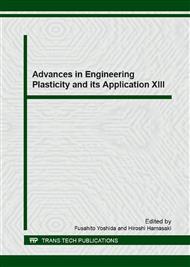p.275
p.281
p.287
p.293
p.299
p.305
p.311
p.316
p.322
Biaxial Ratchetting Deformation of Solders Considering Halt Conditions
Abstract:
Recently, Halt (Highly accelerated limit test) is widely employed for evaluation of reliability of electronic products. Halt condition is quite severe. The tested products are subjected to mechanical impacts, thermal shock, and vibration at same time. However, there has not been a reasonable and accurate evaluation method for Halt yet. To construct an accurate evaluation method of Halt, basic deformation mechanism of parts of the electronic products should be clarified from both experimental and theoretical points of view. In this paper, focusing on solder joints of circuit boards of electronic products, ratchetting deformation, especially, biaxial ratchetting deformation of solder joints is revealed from both experimentally and theoretically. The authors have already conducted biaxial ratchetting test combining axial and torsional cyclic loading using a tubular specimen of Type 304 stainless steel. However, as for solders, it is difficult to make tubular specimen. Since size of the solder joints is micron, a small size joint specimen of copper tube and solder is employed in this paper. First, to confirm the quality of the joint specimen such as boundary between copper and solder, both the tensile and cyclic loading tests are conducted at several temperatures using Sn-3Ag-0.5Cu. The basic characteristic of tensile and fatigue failure is obtained from these tests. After the confirmation of the accuracy of the joint specimen, biaxial ratchetting tests are conducted superposing the tensile load on cyclic torsion. The biaxial ratchetting tests are conducted using a biaxial loading testing machine developed for the joint specimens of solder and copper.
Info:
Periodical:
Pages:
299-304
Citation:
Online since:
December 2016
Keywords:
Price:
Сopyright:
© 2017 Trans Tech Publications Ltd. All Rights Reserved
Share:
Citation:


